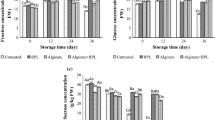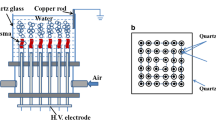Abstract
The aim of this study was to investigate the effect of cut type and pulsed light (PL) fluence on microbiological stability and quality of fresh-cut cantaloupes. Fresh-cut cantaloupes with various cut types (cuboid, triangular prism and sphere) were treated with PL technology at 6 J/cm2. Samples were exposed to PL treatment at fluences of 2.7, 7.8, 11.7 and 15.6 J/cm2 followed by storage at 4 ± 1 °C for 28 days. Microbiological quality, headspace composition, firmness, colour, pH, titratable acidity, total soluble solids, total phenolic content and ascorbic acid content of fresh-cut cantaloupes were determined. Spherical shape was found to be the most suitable shape for PL treatment of fresh-cut cantaloupes due to its significantly lowest (p ≤ 0.05) microbial counts before and after the PL treatment. No significant (p > 0.05) effect was observed for firmness, colour, total soluble solids and total phenolic content of fresh-cut cantaloupes throughout the storage study. Pulsed light treatment using 7.8 J/cm2 was the best for extending shelf life of fresh-cut cantaloupes with extension of 8 days longer at 4 ± 1 °C compared to the control while maintaining the ascorbic acid content. In conclusion, PL treatment is a potential technique for extending the shelf life of fresh-cut cantaloupes by inactivating microorganisms without compromising the nutritional value.



Similar content being viewed by others
References
Abida J, Rayees B, Masoodi FA (2014) Pulsed light technology: a novel method for food preservation. Int Food Res J 21:839–848
Agar IT, Streif J, Bangerth F (1997) Effect of high CO2 and controlled atmosphere (CA) on the ascorbic and dehydroascorbic acid content of some berry fruits. Postharvest Biol Tec 11:47–55. doi:10.1016/S0925-5214(97)01414-2
Amaro AL, Beaulieu JC, Grimm CC, Stein RE, Almeida DPF (2012) Effect of oxygen on aroma volatiles and quality of fresh-cut cantaloupe and honeydew melons. Food Chem 130:49–57. doi:10.1016/j.foodchem.2011.06.052
AOAC (1990) Official methods of analysis of the association of office analytical chemists, 15th edn. Association of Official Analytical Chemists, Washington, D.C
Argañosa ACSJ, Raposo MFJ, Teixeira PCM, Morais AMMB (2008) Effect of cut-type on quality of minimally processed papaya. J Sci Food Agric 88:2050–2060. doi:10.1002/jsfa.3309
Beaulieu JC, Lea JM (2007) Quality changes in cantaloupe during growth, maturation, and in stored fresh-cut cubes prepared from fruit harvested at various maturities. J Am Soc Hortic Sci 132:720–728
Cao S, Hu Z, Pang B, Wang H, Xie H, Wu F (2010) Effect of ultrasound treatment on fruit decay and quality maintenance in strawberry after harvest. Food Control 21:529–532. doi:10.1016/j.foodcont.2009.08.002
Centers of Disease Control and Prevention (CDC) (2015) List of selected multistate foodborne outbreak investigations. Centers of Disease Control and Prevention. http://www.cdc.gov/foodsafety/outbreaks/multistate-outbreaks/outbreaks-list.html. Accessed 29 April 2015
Charles F, Vidal V, Olive F, Filgueiras H, Sallanon H (2013) Pulsed light treatment as new method to maintain physical and nutritional quality of fresh-cut mangoes. Innov Food Sci Emerg 18:190–195. doi:10.1016/j.ifset.2013.02.004
Chimbombi E, Moreira RG, Castell-Perez EM, Puerta-Gomez AF (2013) Assessing accumulation (growth and internal mobility) of salmonella typhimurium LT2 in fresh-cut cantaloupe (cucumis melo L.) for optimization of decontamination strategies. Food Control 32:574–581. doi:10.1016/j.foodcont.2013.01.042
Danyen MS, Boodia N, Ruggoo A (2011) Effect of cutting shapes and thicknesses on the quality of minimally processed pineapple (annas comosus), cv. ‘queen Victoria’. Afr J Food Agric Nutr Dev 11:5525–5538
Dunn JE, Clark RW, Asmus JF, Pearlman JS, Boyer K, Painchaud F (1989) US Patent Number:4871559
Food and Drug Administration (FDA) (2007) Guide to minimise microbial food safety hazards for fresh-cut fruits and vegetables. Food and Drug Administration. http://www.fda.gov/Food/GuidanceRegulation/GuidanceDocumentsRegulatoryInformation/ucm064458.htm. Accessed 14 November 2014
Fu L, Xu BT, Xu XR, Gan RY, Zhang Y, Xia EQ, Li HB (2011) Antioxidant capacities and total phenolic contents of 62 fruits. Food Chem 129:345–350. doi:10.1016/j.foodchem.2011.04.079
Gómez PL, García-Loredo A, Nieto A, Salvatori DM, Guerrero S, Alzamora SM (2012) Effect of pulsed light combined with an antibrowning pretreatment on quality of fresh cut apple. Innov Food Sci Emerg 16:102–112. doi:10.1016/j.ifset.2012.05.011
Gómez-López VM, Ragaert P, Debevere J, Devlieghere F (2007) Pulsed light for food decontamination: a review. Trends Food Sci Technol 18:464–473. doi:10.1016/j.tifs.2007.03.010
Institute of Food Science and Technology (IFST) (1999) Development and use of microbiological criteria for foods. Institute of Food Science and Technology. http://pdfs.findtheneedle.co.uk/16898.pdf. Accessed 12 June 2014
Ignat A, Manzocco L, Maifreni M, Bartolomeoli I, Nicoli MC (2014) Surface decontamination of fresh-cut apple by pulsed light: effects on structure, color and sensory properties. Postharvest Biol Tec 91:122–127. doi:10.1016/j.postharvbio.2014.01.005
Kim J, Moreira R, Castell-Perez E (2010) Simulation of pathogen inactivation in whole and fresh-cut cantaloupe (cucumis melo) using electron beam treatment. J Food Eng 97:425–433. doi:10.1016/j.jfoodeng.2009.10.038
Lamikanra O, Watson MA (2001) Effects of ascorbic acid on peroxidase and polyphenoloxidase activities in fresh-cut cantaloupe melon. J Food Sci 66:1283–1286. doi:10.1111/j.1365-2621.2001.tb15202.x
Lamikanra O, Chen JC, Banks D, Hunter PA (2000) Biochemical and microbial changes during the storage of minimally processed cantaloupe. J Agric Food Chem 48:5955–5961
Larson AE, Johnson EA (1999) Evaluation of botulinal toxin production in packaged fresh-cut cantaloupe and honeydew melons. J Food Prot 62:948–952
Lasagabaster A, de Marañón IM (2014) Survival and growth of listeria innocua treated by pulsed light technology: impact of post-treatment temperature and illumination conditions. Food Microbiol 41:76–81. doi:10.1016/j.fm.2014.02.001
Manzocco L, Da Pieve S, Maifreni M (2011) Impact of UV-C light on safety and quality of fresh-cut melon. Innov Food Sci Emerg 12:13–17
Munira ZA, Rosnah S, Zaulia O, Russly AR (2013) Effect of postharvest storage of whole fruit on physico-chemical and microbial changes of fresh-cut cantaloupe (cucumis melo L. reticulatus cv. Glamour). Int Food Res J 20:501–508
Murugesan R, Orsat V, Lefsrud M (2012) Effect of pulsed ultraviolet light on the total phenol content of elderberry (sambucus nigra) fruit. Food Nutr Sci 3:774–783. doi:10.4236/fns.2012.36104
Oliveira AB, Moura CFH, Gomes-Filho E, Marco CA, Urban L, Miranda MRA (2013) The impact of organic farming on quality of tomatoes is associated to increased oxidative stress during fruit development. PLoS One 8:e56354. doi:10.1371/journal.pone.0056354
Oms-Oliu G, Soliva-Fortuny R, Martín-Belloso O (2008) Using polysaccharide-based edible coatings to enhance quality and antioxidant properties of fresh-cut melon. LWT Food Sci Technol 41:1862–1870. doi:10.1016/j.lwt.2008.01.007
Oms-Oliu G, Martín-Belloso O, Soliva-Fortuny R (2010) Pulsed light treatments for food preservation. A review. Food Bioprocess Tech 3:13–23. doi:10.1007/s11947-008-0147-x
Pintó E, Lentheric I, Vendrell M, Larrigaudière C (2001) Role of fermentative and antioxidant metabolisms in the induction of core browning in controlled-atmosphere stored pears. J Sci Food Agric 81:364–370. doi:10.1002/1097-0010(200102)81
Ramos-Villarroel AY, Martín-Belloso O, Soliva-Fortuny R (2011) Bacterial inactivation and quality changes in fresh-cut avocado treated with intense light pulses. Eur Food Res Technol 233:395–402. doi:10.1007/s00217-011-1533-6
Ramos-Villarroel AY, Aron-Maftei N, Martín-Belloso O, Soliva-Fortuny R (2012) Influence of spectral distribution on bacterial inactivation and quality changes of fresh-cut watermelon treated with intense light pulses. Postharvest Biol Tec 69:32–39. doi:10.1016/j.postharvbio.2012.03.002
Ramos-Villarroel A, Aron-Maftei N, Martín-Belloso O, Soliva-Fortuny R (2014) Bacterial inactivation and quality changes of fresh-cut avocados as affected by intense light pulses of specific spectra. Int J Food Sci Technol 49:128–136. doi:10.1111/ijfs.12284
Salama MS, Musafija-Jeknic T, Sandine WE, Giovannoni SJ (1995) An ecology study of lactic acid bacteria: isolation of new strains of Lactococcus lactis subspecies cremoris. J Dairy Sci 78:1004–1017. doi:10.3168/jds.S0022-0302(95)76716-9
Saltveit ME (2002) Respiratory metabolism. United States Department of Agriculture. http://www.ba.ars.usda.gov/hb66/respiratoryMetab.pdf. Accessed 10 December 2014
Soliva-Fortuny RC, Grigelmo-Miguel N, Odriozola-Serrano I, Gorinstein S, Martín-Belloso O (2001) Browning evaluation of ready-to-eat apples as affected by modified atmosphere packaging. J Agric Food Chem 49:3685–3690. doi:10.1021/jf010190c
Acknowledgments
The authors are grateful to Universiti Putra Malaysia for supporting this study through Project No. 05-02-12-2047RU.
Author information
Authors and Affiliations
Corresponding author
Rights and permissions
About this article
Cite this article
Koh, P.C., Noranizan, M.A., Karim, R. et al. Microbiological stability and quality of pulsed light treated cantaloupe (Cucumis melo L. reticulatus cv. Glamour) based on cut type and light fluence. J Food Sci Technol 53, 1798–1810 (2016). https://doi.org/10.1007/s13197-015-2139-y
Revised:
Accepted:
Published:
Issue Date:
DOI: https://doi.org/10.1007/s13197-015-2139-y




